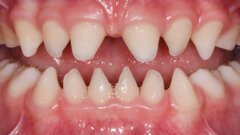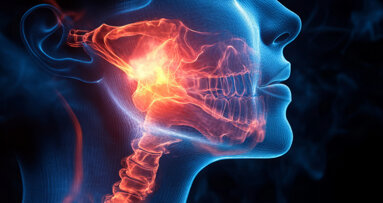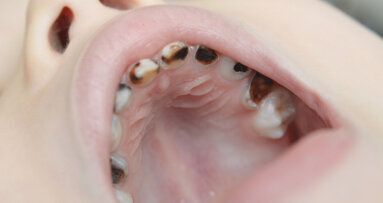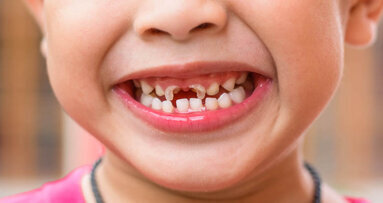SEATTLE, USA: It is known that the first 1,000 days after conception significantly affects a person’s life expectancy and disease susceptibility. While low birth weight, for example, has been established as a primary marker of early-life stress, the findings of a new study have suggested that lower-face asymmetries, assessed according to the asymmetry of occlusion, are a marker of environmental stress and cerebral lateralization during early development too.
In the study, researchers at the University of Washington assessed data on 6,654 U.S. adolescents collected between 1966 and 1970 as part of the National Health and Nutrition Examination Survey. More recent data were not used owing to a lack of current information on the prevalence of lower-face asymmetries in the U.S. population.
In total, an estimated 1 in 4 U.S. adolescents have lower-face asymmetries, the researchers concluded. Retrognathic asymmetries (17 percent), the most common lower-face asymmetry in the U.S. population, were found to fluctuate randomly between the left and right sides of the face. Such randomness indicates early-life stress, said lead author Prof. Philippe Hujoel, from the university’s School of Dentistry.
Hujoel emphasized that malaligned teeth, overbite and underbite have to be distinguished from asymmetric occlusion, as these conditions can be associated with asymmetric and symmetric occlusions, the last of which is largely a reflection of genetics, not environmental stress.
Further research is needed to identify whether lower-face asymmetries are predictive of chronic diseases in living populations in the same way that skull asymmetries have been associated with degenerative diseases in long-deceased populations.
The study, titled “Lower face asymmetry as a marker for developmental instability,” was published online on April 11 in the American Journal of Human Biology ahead of print.
Tags:
GOTHENBURG, Sweden: In his book The Nordic Guide to Living 10 Years Longer, Dr Bertil Marklund, a general medical practitioner and an adjunct professor at ...
NEW YORK, USA: Evidence found in primary dentition has suggested that exposure to specific toxins and nutrients is associated with the risk of developing ...
HONG KONG: Autism spectrum disorder (ASD) is a global public health concern. Early identification and timely support for children with ASD can significantly...
ROCHESTER, N.Y., US: In what is thought to be the first study to directly link prenatal stress hormones with primary tooth eruption, researchers in the US ...
PITTSBURGH, US: A new US$17 million research initiative led by the University of Pittsburgh is set to revolutionise understanding and treatment of ...
BIRMINGHAM, Ala., USA: There is a recommendation for children to have a dental visit by 6 months of age, but there is insufficient evidence of improved ...
On 3 May, Swedish implant manufacturer Neoss will be hosting its third annual webinar to commemorate the birthday of Prof. Per-Ingvar Brånemark, the father...
BAIKIVTSKI, Ukraine/COLOGNE, Germany: At the upcoming International Dental Show (IDS), GALIT, a Ukrainian company specialising in the development and ...
DURHAM, N.C., U.S./BIRMINGHAM, U.K.: Cancers that occur in the back of the mouth or in the upper throat are difficult to spot and, as a result, are often ...
ALEXANDRIA, Va., U.S.: Protecting children against the early onset of dental caries is something all dentists should consider a priority. According to the ...
Live webinar
Wed. 14 January 2026
12:00 pm EST (New York)
Dr. Théo Laplane, Dr. Robert Gottlander DDS
Live webinar
Fri. 16 January 2026
12:00 pm EST (New York)
Live webinar
Mon. 19 January 2026
1:00 pm EST (New York)
Philipp Kopp, Michael Seeber
Live webinar
Thu. 22 January 2026
9:00 am EST (New York)
Prof. Judith Jones D.D.S; M.P.H., Prof. Kakuhiro Fukai D.D.S., Ph.D, Dr. Bathsheba (Bethy) Turton
Live webinar
Thu. 22 January 2026
2:00 pm EST (New York)
Dr. Nicola M. Grande DDS, PhD
Live webinar
Wed. 28 January 2026
8:00 am EST (New York)
Live webinar
Wed. 28 January 2026
11:00 am EST (New York)
Prof. Dr. Jan-Frederik Güth



 Austria / Österreich
Austria / Österreich
 Bosnia and Herzegovina / Босна и Херцеговина
Bosnia and Herzegovina / Босна и Херцеговина
 Bulgaria / България
Bulgaria / България
 Croatia / Hrvatska
Croatia / Hrvatska
 Czech Republic & Slovakia / Česká republika & Slovensko
Czech Republic & Slovakia / Česká republika & Slovensko
 France / France
France / France
 Germany / Deutschland
Germany / Deutschland
 Greece / ΕΛΛΑΔΑ
Greece / ΕΛΛΑΔΑ
 Hungary / Hungary
Hungary / Hungary
 Italy / Italia
Italy / Italia
 Netherlands / Nederland
Netherlands / Nederland
 Nordic / Nordic
Nordic / Nordic
 Poland / Polska
Poland / Polska
 Portugal / Portugal
Portugal / Portugal
 Romania & Moldova / România & Moldova
Romania & Moldova / România & Moldova
 Slovenia / Slovenija
Slovenia / Slovenija
 Serbia & Montenegro / Србија и Црна Гора
Serbia & Montenegro / Србија и Црна Гора
 Spain / España
Spain / España
 Switzerland / Schweiz
Switzerland / Schweiz
 Turkey / Türkiye
Turkey / Türkiye
 UK & Ireland / UK & Ireland
UK & Ireland / UK & Ireland
 Brazil / Brasil
Brazil / Brasil
 Canada / Canada
Canada / Canada
 Latin America / Latinoamérica
Latin America / Latinoamérica
 USA / USA
USA / USA
 China / 中国
China / 中国
 India / भारत गणराज्य
India / भारत गणराज्य
 Pakistan / Pākistān
Pakistan / Pākistān
 Vietnam / Việt Nam
Vietnam / Việt Nam
 ASEAN / ASEAN
ASEAN / ASEAN
 Israel / מְדִינַת יִשְׂרָאֵל
Israel / מְדִינַת יִשְׂרָאֵל
 Algeria, Morocco & Tunisia / الجزائر والمغرب وتونس
Algeria, Morocco & Tunisia / الجزائر والمغرب وتونس
 Middle East / Middle East
Middle East / Middle East
















































To post a reply please login or register